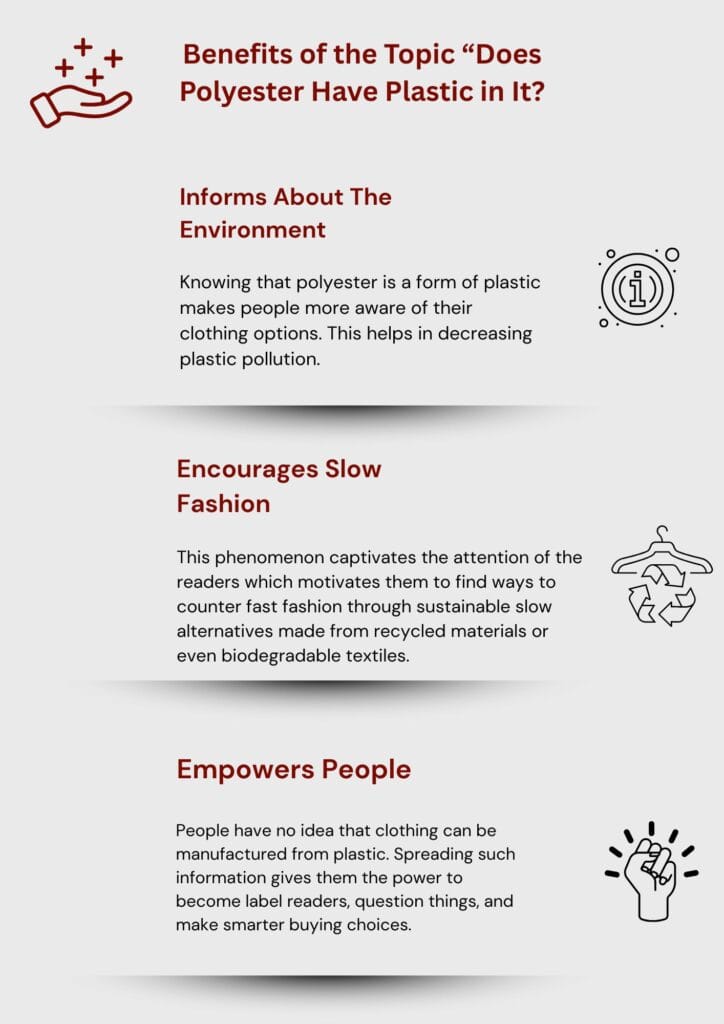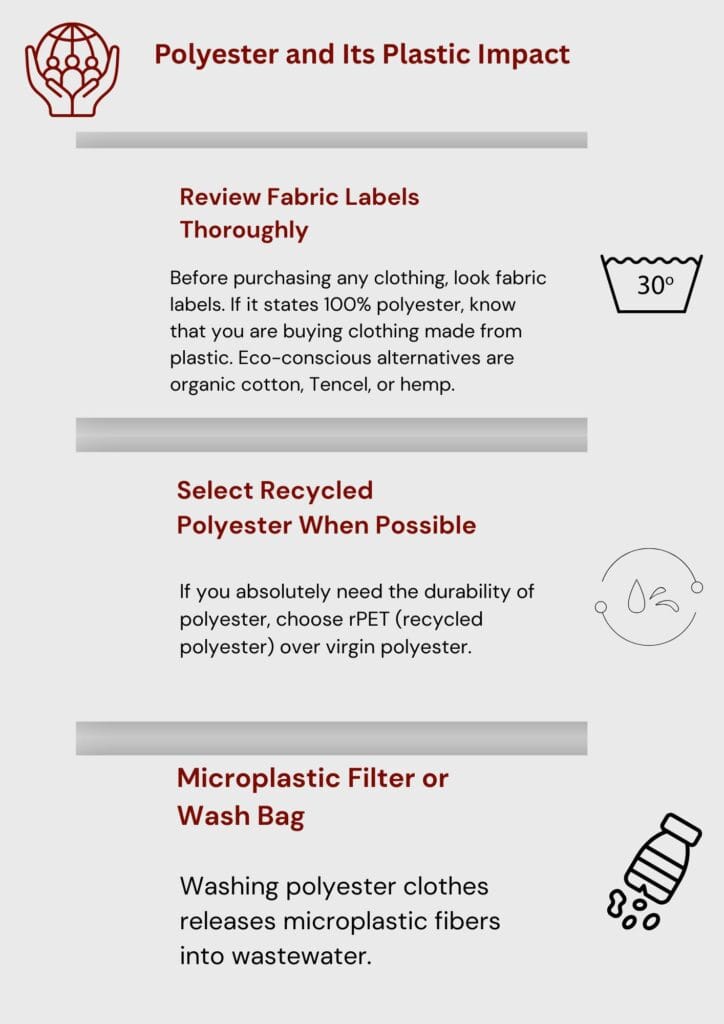Introduction
Polyester is one of the most widely utilized synthetic fabrics in the contemporary world. It is popular because it is not expensive, is durable, and does not get wrinkled or shrunk easily. The ease at which polyester could be made and its versatility made it a textile revolution when it was invented in the 1940s.
Polyester is everywhere and is a part of many products. These include clothing items such as dresses and shirts. Household goods containing polyester include bedsheets, curtains, and furniture upholstery. Additionally, it is also used in industrial packaging and ropes, and even in some forms of insulation. Because polyester is synthetic, it has far more strength and durability than is found in natural fibers.
Regardless of its widespread use, very few people understand that polyester is a type of fabric, and further to that, it is a kind of plastic. Let’s delve deeper.
Is It A Type of Plastic?
Plastic is composed of various substances and polyester is part of that family. Polyester is categorized as plastic and falls under the polymer category as well. It’s better known as PET (Polyethylene Terephthalate) or PBT (Polybutylene Terephthalate) which are types of plastics.
Since polyester is made from petroleum-based materials, it is a synthetic polymer. Many everyday plastics share the same raw material origins. Therefore, if you have ever touched a plastic bottle, you have touched a polyester cousin. This association helps to grasp the underpinning of polyester’s environmental impact.
What separates it from other plastics is only its form—fiber instead of solid plastic. But chemically, there’s little distinction.
How Polyester is Made
Polyester production starts with a petroleum-sourced two-part molecule, ethylene glycol, and terephthalic acid. A chemical reaction occurs, resulting in PET, the same plastic used in drink bottles and food containers.
This PET goes through a melting process where it is spun into fibers. Once cooled and hardened, these fibers are woven into fabrics employed in fashion and industry. Despite polyester fabric’s and plastic bottles’ different appearances, their chemical structures are strikingly similar.
This process proves the deep-rooted connection between polyester and plastic. So next time you touch a polyester shirt, remember that you are literally wearing plastic.
What are the environmental clues why polyester is considered plastic?
Polyster is considered plastic chiefly because of te environmental impact. Like many plastics, polyester can take hundreds of years to decompose in landfills while natural fabrics like cotton wool break down within months or years. Polyester does not biodegrade which makes it a pollutant.
Microplastic shedding is another concern when it comes to washing polyester garments as tiny plastic fibers get released into water. This poses a threat to marine life as these microplastics eventually make their way to rivers, lakes and oceans.
In conclusion, while polyester might look soft and fabric-like, it actually behaves like plastic in the environment. It is persistent, soft, and problematic.
Benefits of the Topic “Does Polyester Have Plastic in It?

Informs About The Environment
Knowing that polyester is a form of plastic makes people more aware of their clothing options. This helps in decreasing plastic pollution.
Encourages Slow Fashion
This phenomenon captivates the attention of the readers which motivates them to find ways to counter fast fashion through sustainable slow alternatives made from recycled materials or even biodegradable textiles.
Empowers People
People have no idea that clothing can be manufactured from plastic. Spreading such information gives them the power to become label readers, question things, and make smarter buying choices.
A plastic pollution crisis, the environmental impact of polyester
When asking does polyester have plastic in it, its equally important to examine the environmental impact of polyester plastic. It is a leading contributor to microplastic pollution, it is estimated that these fragments can be found in humans, inside fishes, and even in Arctic ice and oceans.
Furthermore, the environmental impact of polyester cannot be overlooked. The carbon footprint of polyester is massive, its non biodegradable nature and reliance on fossil fuels creates greehouse gas emissions and global warming alongside melting ice caps. It’s safe to say that it will not be able to compete with cotton as it’s far less energy efficient and emits more co2.
In contrast to polyester, natural fabrics such as cotton, wool, or linen are both biodegradable and renewable resources. Polyester’s impact, however, persists long after use.
Health Risks: Is Wearing Polyester Safe?
Beside environmental concerns, polyester affects individual’s lives as well. It can trap heat and moisture, making it a perfect breeding ground for bacteria. For delicate skin, the results often involve rashes, itching, or some form of irritation.
In addition, polyester is regularly treated with chemical dyes, flame retardants, and even formaldehyde. These treatments can be dangerous, especially when exposed for long periods of time, will likely suffer some allergic reaction or long term skin issues.
While not always hazardous, polyester poses significant risk, making it unsuitable for infants, allergy sufferers, or those with delicate skin.
Sustainable Alternatives to Polyester (And Why They Matter)
What textile options are there instead of polyester? Not to worry, more sustainable substitutes exist nowadays.
- Recycled Polyester (rPET): a type of polyester retrieved from old soft drink bottles. rPET boasts reduced wastes and emissions than traditional polyester, although it’s still plastic at the end of the day.
- PLA (Polylactic Acid): biodegradable corn and sugar can pose PLA, which is used in some eco fabrics.
- Tencel: produced from wood pulp of sustainably harvested trees. It is breathable, eco-friendly, and biodegradable.
- Cotton and Linen: Organic variant of these fabrics are natural decomposable, which preserves the environment.
Picking these substitutes can lessen dependence on polyester sourced from petroleum while making fashion, in general, more eco-conscious.
Polyester and Its Plastic Impact

Review Fabric Labels Thoroughly
Before purchasing any clothing, look fabric labels. If it states 100% polyester, know that you are buying clothing made from plastic. Eco-conscious alternatives are organic cotton, Tencel, or hemp.
Select Recycled Polyester When Possible
If you absolutely need the durability of polyester, choose rPET (recycled polyester) over virgin polyester.
Microplastic Filter or Wash Bag
Washing polyester clothes releases microplastic fibers into wastewater.
Suggestions to Lower Impact of Polyester on Environment
These are some strategies that one could use even if they do not wish to give up polyester.
- Washing on cold temperatures or less frequently are some ways to reduce damage done. Gentle cycle wash and air dry also aid in this. Use of guppy friend wash bags help capture micro plastics.
- Invest in sustainable product using brands that recycle plastic for their garments, as this encourages moral practices.
- Opt for cotton polyester blends instead of pure polyester blends.
Every little effort adds up and propels us closer to sustainability as well as decreasing plastic pollution.
Exposing The Myths Surrounding Plastic And Polyester
There is as yet a handful of myths that surround polyester and plastic. Let us clear out the myths one by one.
Myth 1: “Polyester is natural because it’s used in clothes.”
This statement is false. Just because polyester is part of textile doesn’t mean it is natural. It remains to be a petroleum based plastic.
Myth 2 “All forms of synthetic fabrics equally harm the environment”
While is this partly true, as most synthetics do have a cost to the environment, some of them like recycled polyester or PLA, tend to have a lower impact than virgin polyester.
Myth 3 “Polyester Is sustainable because it last longer”
Durability might help but not if the fabric adds to micro plastic pollution each time it gets washed. Just because the material lasts, doesn’t mean it eco friendly.
Having understanding of these facts allow to have choices when buying clothes and household products.
Conclusion
The answer to the question proposed is obviously yes, it absolutely contains plastic and this remains a shocking truth. It is a synthetic plastic fiber made from petroleum that contributes to plastic pollution. It is true that it provides durability and is inexpensive, but it can greatly affect the nature and health of people in the long run.
FAQs
Yes, polyester is classified as a plastic. It is synthesized from petroleum-based chemicals and is in the same category as PET (Polyethylene Terephthalate), the resin used to manufacture water bottles. So in a way, polyester does not simply contain plastic— it is plastic.
In most cases, polyester is regarded as safe to wear, but it may cause irritation to sensitive skin. It is not ventilated well and may accummulate sweat which may cause rashes or allergic reactions in a few individuals. Choosing natural fabrics may alleviate polyester related issues.
Polyester is non-biodegradable, and takes hundreds of years to decompose. Additionally, it releases microplastics during washing, which pollutes oceans and wildlife. Its production also adds on to fossil fuel dependency, raising carbon emissions.


